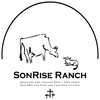This time is flat out hectic for us. We have to feed, house and teach these eager young learners, and we work hard to be sure all their educational needs are met. We've strived over the years to develop a syllabus that is both meaningful and educational.
It's really got to hit home - we want to leave a lasting impression.
This year, we are teaching a new subject - the Zeedyk method of erosion control. Its part of a plan that was used to restore degraded meadows in sagebrush rangelands located in the upper Gunnison River Basin in Colorado.
We'll be teaching from a manual out of the NRCS found here.
| co-nrcs_range_technical_note_40_gunnison_zeedyk-structures_5-18__1_.pdf |
Great question -
Most of the time, it's definition varies from person to person. But for us, we have taken a modified version of Rodales in the late 70's - his was kind of an esoteric - hippy - world view that we really like, but wanted to change a bit to suit our needs and ethos.
Here's ours...
- Pluralism lies at the heart of regenerative agriculture, promoting diversity in multiple dimensions. Farmers embrace a wide variety of plant species, cultivating traditional and lesser-known varieties to foster resilience and adaptability. This biodiversity not only protects against crop diseases and pests but also contributes to the overall health of the ecosystem. In addition, regenerative agriculture embraces diversity in businesses, people, and cultures within the farming community, creating a vibrant and resilient local economy.
- Protection is a fundamental principle of regenerative agriculture, emphasizing the importance of preserving and nurturing the land. By increasing surface cover through practices like cover cropping and agroforestry, farmers minimize erosion and enhance the presence of beneficial microbial populations near the surface. This protects the soil from degradation, retains moisture, and supports overall soil health. Moreover, regenerative agriculture fosters economic and cultural resilience, safeguarding against fluctuations by promoting a diverse array of businesses and skill sets within the community.
- Purity is upheld through regenerative agricultural practices by minimizing disturbances to the soil. By adopting reduced tillage and maintaining vegetative cover, farmers prevent erosion, promote nutrient cycling, and preserve the integrity of the ecosystem. This approach ensures the long-term fertility and productivity of the soil, while also minimizing the need for synthetic inputs.
- Permanence is achieved by prioritizing the presence of living roots in the soil. Through continuous cover cropping, crop rotation, and agroforestry, farmers maintain an active and nourished soil ecosystem year-round. This constant presence of living roots enhances soil structure, carbon sequestration, nutrient cycling, and the overall health and resilience of the farming system.
- Pasturing adds another layer of benefit to regenerative agriculture. By practicing well-managed grazing and mob-grazing techniques, farmers optimize soil health, nutrient cycling, and organic matter accumulation. The combination of diverse plant species and strategic livestock integration creates a synergistic effect, enhancing soil fertility and productivity while promoting animal welfare.
Our take on thing tends to be really strange, and quite effective. I call it the inverse-weird effect. The more lunatic I get, the more effective our soils become. That's why you find us doing all kinds of weird stuff.
Stuff that actually works.
A few days ago I answered a question about how we worm our Cows. My reply stunned even me, after re-reading it, I thought I might post it here...
Next we bring them into the Corrals and run them through the chute. Each one gets the DE from just below the base of the neck all the way to the top of the tail. I have it in a pail and use a pair of gloves with a mask and get it all over their bodies as much as possible.
Finally, we put them in a pen with a large water trough and dilute Shaklee Basic H (we buy the 30 gallon drum, no I am not a dealer) into the water. I use about 2 to 3 cups for a 50 gallon trough. Make sure that you reintroduce it after the most dominant cows have had the first drinks. I look to make sure they each have soap bubbles all over their noses (by now they are pasty white with DE, and have soap bubbles on their noses - it becomes pretty easy to figure out why the neighboring ranches make fun of us!).
I check across the herd to make sure everyone has had a drink.
That is our entire natural worming and parasite control program. We have excellent results with this, but took years for us to figure out."
You can join by clicking here. And, as always, if you miss it, we will post a recording here.
I am looking forward to seeing each of you.
Douglas Lindamood
Chief Piglet Chaser, Chicken Whisperer and Calf Wrangler
SonRise Ranch

 RSS Feed
RSS Feed